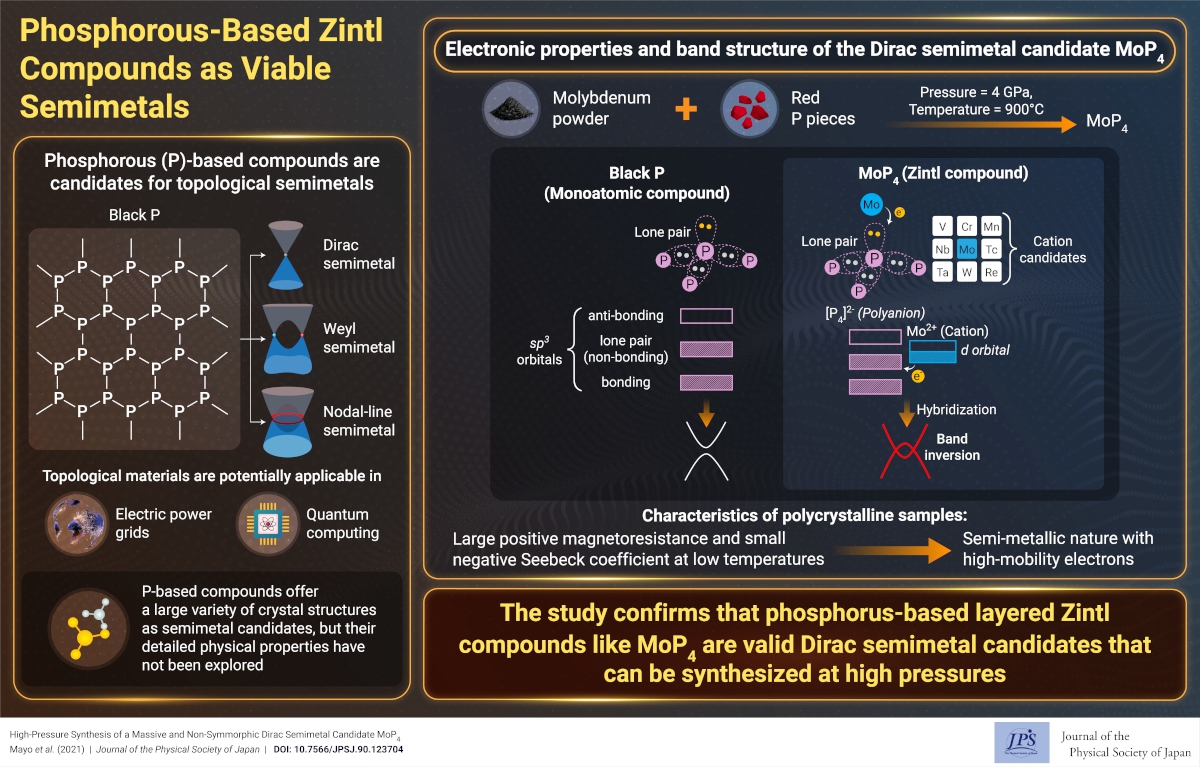Phosphorous-Based Zintl Compounds as Viable Semimetals
© The Physical Society of Japan
This article is on
High-Pressure Synthesis of a Massive and Non-Symmorphic Dirac Semimetal Candidate MoP4
(JPSJ Editors' Choice)
J. Phys. Soc. Jpn. 90, 123704 (2021).
A black-phosphorus-derived Zintl compound, MoP4, is obtained by high-pressure synthesis. The material exhibits a non-quadratic large magnetoresistance and semi-metallic Seebeck behavior, as predicted by the first principles calculations yielding massive and non-symmorphic Dirac semimetal states.

Topological materials, which have non-trivial geometrical properties in their band structures, have attracted attention owing to their exotic quantum transport phenomena and applications to ultrafast and low-power-consumption devices. Dirac electron systems, such as graphene, are a typical example. To exploit the quantum properties inherent in Dirac electronic materials and to advance their functionality, a system that facilitates chemical band engineering is desirable. However, the relationship between the momentum-space topological band structure and the real-space crystal structure is generally not self-evident, and an ideal system to explore such a relationship has yet to be reported.
To realize topological semimetal states, band inversion between the valence and conduction bands is required. To realize such band structures, the authors focused on phosphorus-based Zintl compounds. Zintl compounds are materials consisting of nonmetallic elements. They form covalent polyanion clusters, and metal cations; hence, the crystals have an intermediate character between ionic and covalent crystals. The key feature is that the octet rule is satisfied in the polyanion clusters by receiving electrons from the metal cations and forming lone electron pairs, thereby tending to yield semiconducting or semi-metallic electronic structures.
The authors have successfully performed high-pressure synthesis of single-crystal and polycrystalline MoP4, a Zintl compound with a layered structure derived from black phosphorus, and they found that this system is a promising platform for exploring new topological semimetals. In the high-quality polycrystalline sample, a non-quadratic large positive magnetoresistance was observed at low temperatures, and a sign change from positive to negative in the Seebeck coefficient was observed with decreasing temperature, suggesting that MoP4 is a semimetal with high mobility electron carriers. First principles calculations using refined single-crystal structure parameters revealed that a Dirac-semimetal-like band dispersion consisting of Mo-4d and phosphorus-3p orbitals is realized near the Fermi level and is responsible for the high mobility electron carriers.
This presents a general case that the topological electronic structure can be generated and controlled on a real-space basis through hybridization of the valence orbital of the metal cation inserted between the phosphorus polyanion layers and the p-orbital of phosphorus. Because MP4 can encapsulate various transition metal ions other than Mo2+, such as Cr2+ and W2+, the design and development of phosphorus-based Dirac materials with various functions optimized via chemical substitution are expected to advance in the future.
Material design focusing on black phosphorus, a well-known high mobility semiconductor and Dirac semimetal candidate, is expected to be a promising guideline for the strategic development of topological materials based on structure-function relationships.
(Written by A. H. Mayo on behalf of all authors)
High-Pressure Synthesis of a Massive and Non-Symmorphic Dirac Semimetal Candidate MoP4
(JPSJ Editors' Choice)
J. Phys. Soc. Jpn. 90, 123704 (2021).
Share this topic
Fields
Related Articles
-
Which is Moving?—Pinning Down the Origin of Fluctuations in Muon Spin Relaxation—
Structure and mechanical and thermal properties in condensed matter
Cross-disciplinary physics and related areas of science and technology
2024-3-28
The study demonstrated that we can distinguish between the diffusion motion of the muon itself and the motion of the surrounding ions in muon spin relaxation.
-
Variety of Mechanically Induced Spin Currents in Rashba Systems
Electronic transport in condensed matter
Magnetic properties in condensed matter
Structure and mechanical and thermal properties in condensed matter
2024-3-22
Various types of spin currents, including unconventional types, are generated in Rashba spin-orbit coupled systems by dynamic lattice distortions associated with, for example, surface acoustic waves.
-
Relation between Mean-Field Theory and Atomic Structures in Chalcogenide Glasses
Structure and mechanical and thermal properties in condensed matter
2024-2-1
The authors conducted various of X-ray and neutron scattering experiments on typical chalcogenide glasses and clarified the relationship between the atomic structure and simple rigidity percolation theory.
-
Towards Uncovering the Hidden Order of URu2Si2 Phase Transition
Magnetic properties in condensed matter
Electronic structure and electrical properties of surfaces and nanostructures
2024-1-11
We propose a chiral charge as the hidden order parameter in URu2Si2 and present experiments to detect it by focusing on breakings of mirror and inversion symmetries at the local uranium ion.
-
Possible Origin of High Thermoelectric Power Factor in Ultrathin FeSe: A Two-band Model
Electronic structure and electrical properties of surfaces and nanostructures
Structure and mechanical and thermal properties in condensed matter
Cross-disciplinary physics and related areas of science and technology
2023-12-21
The high thermoelectric power factor observed in ultrathin FeSe can be theoretically explained by a two-band model with chemical potential between upper and lower band bottoms.
